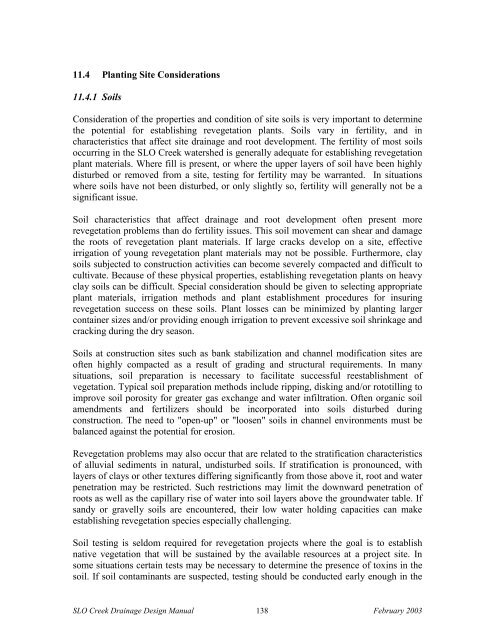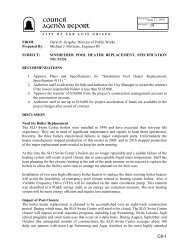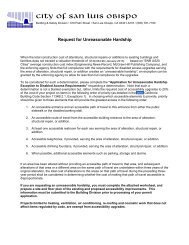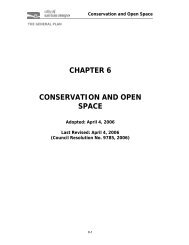Drainage Design Manual - the City of San Luis Obispo
Drainage Design Manual - the City of San Luis Obispo
Drainage Design Manual - the City of San Luis Obispo
You also want an ePaper? Increase the reach of your titles
YUMPU automatically turns print PDFs into web optimized ePapers that Google loves.
11.4 Planting Site Considerations11.4.1 SoilsConsideration <strong>of</strong> <strong>the</strong> properties and condition <strong>of</strong> site soils is very important to determine<strong>the</strong> potential for establishing revegetation plants. Soils vary in fertility, and incharacteristics that affect site drainage and root development. The fertility <strong>of</strong> most soilsoccurring in <strong>the</strong> SLO Creek watershed is generally adequate for establishing revegetationplant materials. Where fill is present, or where <strong>the</strong> upper layers <strong>of</strong> soil have been highlydisturbed or removed from a site, testing for fertility may be warranted. In situationswhere soils have not been disturbed, or only slightly so, fertility will generally not be asignificant issue.Soil characteristics that affect drainage and root development <strong>of</strong>ten present morerevegetation problems than do fertility issues. This soil movement can shear and damage<strong>the</strong> roots <strong>of</strong> revegetation plant materials. If large cracks develop on a site, effectiveirrigation <strong>of</strong> young revegetation plant materials may not be possible. Fur<strong>the</strong>rmore, claysoils subjected to construction activities can become severely compacted and difficult tocultivate. Because <strong>of</strong> <strong>the</strong>se physical properties, establishing revegetation plants on heavyclay soils can be difficult. Special consideration should be given to selecting appropriateplant materials, irrigation methods and plant establishment procedures for insuringrevegetation success on <strong>the</strong>se soils. Plant losses can be minimized by planting largercontainer sizes and/or providing enough irrigation to prevent excessive soil shrinkage andcracking during <strong>the</strong> dry season.Soils at construction sites such as bank stabilization and channel modification sites are<strong>of</strong>ten highly compacted as a result <strong>of</strong> grading and structural requirements. In manysituations, soil preparation is necessary to facilitate successful reestablishment <strong>of</strong>vegetation. Typical soil preparation methods include ripping, disking and/or rototilling toimprove soil porosity for greater gas exchange and water infiltration. Often organic soilamendments and fertilizers should be incorporated into soils disturbed duringconstruction. The need to "open-up" or "loosen" soils in channel environments must bebalanced against <strong>the</strong> potential for erosion.Revegetation problems may also occur that are related to <strong>the</strong> stratification characteristics<strong>of</strong> alluvial sediments in natural, undisturbed soils. If stratification is pronounced, withlayers <strong>of</strong> clays or o<strong>the</strong>r textures differing significantly from those above it, root and waterpenetration may be restricted. Such restrictions may limit <strong>the</strong> downward penetration <strong>of</strong>roots as well as <strong>the</strong> capillary rise <strong>of</strong> water into soil layers above <strong>the</strong> groundwater table. Ifsandy or gravelly soils are encountered, <strong>the</strong>ir low water holding capacities can makeestablishing revegetation species especially challenging.Soil testing is seldom required for revegetation projects where <strong>the</strong> goal is to establishnative vegetation that will be sustained by <strong>the</strong> available resources at a project site. Insome situations certain tests may be necessary to determine <strong>the</strong> presence <strong>of</strong> toxins in <strong>the</strong>soil. If soil contaminants are suspected, testing should be conducted early enough in <strong>the</strong>SLO Creek <strong>Drainage</strong> <strong>Design</strong> <strong>Manual</strong> 138 February 2003
















